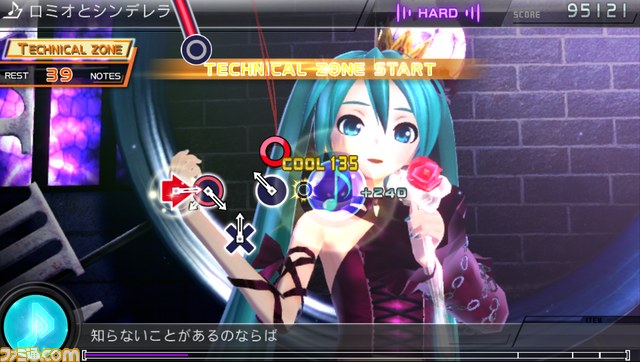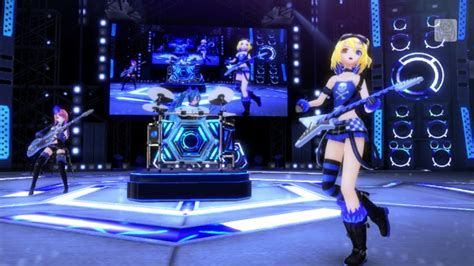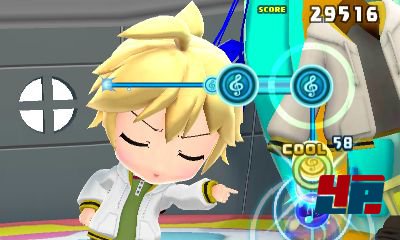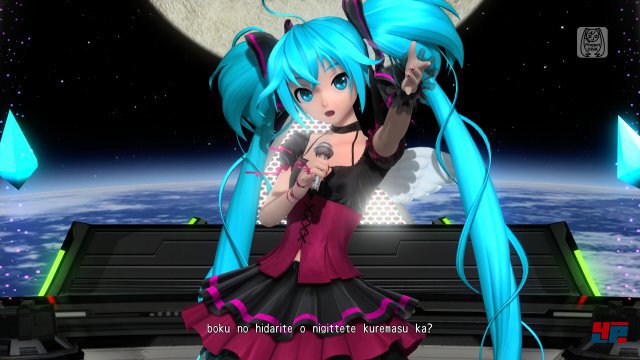There has long been a history of music rhythm games coming out of Japan but in recent years they've really taken to home on portables with a key trinity of series taking the lead, Namco's Taiko series and DJ Max make two but there's only one queen...
Hatsune Miku
Mainline Entry 01 - Hatsune Miku: Project DIVA
Formats: Playstation Portable and Playstation 3
With the vocaloid singer taking centre stage, the original game set up the formula that the series has followed ever since. Timed with the many songs the game features, button icons drift into the screen space in front of the video until they align with a prompt where the player attempts to hit the corresponding button in time. With 4-5 difficulty settings, controls rise from a basic X only mode up to a frantic level with the player trying to keep pace with the entire controller.

Spin Off Entry 01 - Hatsune Miku: Project DIVA Arcade
Formats: Arcade
Porting the first game to the arcade, the machine added large buttons and updated the visuals along with some physics changes.

Mainline Entry 02 - Hatsune Miku: Project DIVA 2nd
Formats: Playstation Portable and Playstation 3
Adding in extra prompts and a hold button feature, the sequel expanded the combination options whilst offering a third of the track list as returning songs coupled with two thirds new.

Spin Off Entry 02 - Hatsune Miku: Project DIVA Extend
Formats: Playstation Portable and Playstation 3
Mainline Entry 03 - Hatsune Miku: Project DIVA F
Formats: Playstation Vita and Playstation 3
A new handheld brought on a new entry with F, though this time a port arrived on PS3 also with the series taking its first official steps to broaden out to western audiences. Along with improved visuals the game brought in the Star and Chance Systems.

Spin Off Entry 03 - Hatsune Miku: Project Mirai
Formats: Nintendo 3DS
The new handheld from Nintendo was slow to start off but quickly proved far more popular than Sony's platform forcing Sega to branch out with this side game that Nenderoided Miku. Using a different input approach and art style, the game none the less continued the spirit of the other entries and repurposed many of the tracks.

Spin Off Entry 04 - Hatsune Miku: Project Mirai 2
Formats: Nintendo 3DS
Mainline Entry 04 - Hatsune Miku: Project DIVA F 2nd
Formats: Playstation Vita and Playstation 3
The new entry followed closely on the first Vita title but added the more troublesome addition of touch controls, handled by the right analogue stick in the console port. Other than that addition it was a very typical sequel and performed well despite the change.

Spin Off Entry 05 - Hatsune Miku: Project Mirai DX
Formats: Nintendo 3DS
Mainline Entry 05 - Hatsune Miku: Project DIVA X
Formats: Playstation Vita and Playstation 4
The title of this sequel referred to its place of being the tenth entry in the series though not quite as you see here with Sega classing the mainline titles and side bits as Dreamy Theatre and updates as mainline entries. Rush notes where the player hammers buttons was added in place of other systems for this entry whilst introducing a mild quest mode though the game took a knock due to a lack on content compared to previous entries.

Spin Off Entry 06 - Hatsune Miku: Project DIVA Future Tone
Formats: Playstation 4
Released in DLC chunks, the port of the arcade games came as a free initial three song download then in two DLC batches. Future Tone contained all 127 songs that had appeared in the DIVA series whereas Colorful Tone contained the 95 Mirai and Arcade songs. Due to the arcade games basis on the earlier entries the gameplay is pulled back to a purer form and it (almost) represents the most definitive way to play the series.

Spin Off Entry 07 - Hatsune Miku: VR Future Live
Formats: Playstation 4
Spin Off Entry 08 - Hatsune Miku: Project DIVA Future Tone DX
Formats: Playstation 4
The most recent release is a slight expansion on FT, combining every module and adding a slim number of additional tracks, this being the culmination with every song you'd ever need.

Share your thoughts and memories of the Hatsune Miku series
Hatsune Miku
Mainline Entry 01 - Hatsune Miku: Project DIVA
Formats: Playstation Portable and Playstation 3
With the vocaloid singer taking centre stage, the original game set up the formula that the series has followed ever since. Timed with the many songs the game features, button icons drift into the screen space in front of the video until they align with a prompt where the player attempts to hit the corresponding button in time. With 4-5 difficulty settings, controls rise from a basic X only mode up to a frantic level with the player trying to keep pace with the entire controller.

Spin Off Entry 01 - Hatsune Miku: Project DIVA Arcade
Formats: Arcade
Porting the first game to the arcade, the machine added large buttons and updated the visuals along with some physics changes.
Mainline Entry 02 - Hatsune Miku: Project DIVA 2nd
Formats: Playstation Portable and Playstation 3
Adding in extra prompts and a hold button feature, the sequel expanded the combination options whilst offering a third of the track list as returning songs coupled with two thirds new.

Spin Off Entry 02 - Hatsune Miku: Project DIVA Extend
Formats: Playstation Portable and Playstation 3
Mainline Entry 03 - Hatsune Miku: Project DIVA F
Formats: Playstation Vita and Playstation 3
A new handheld brought on a new entry with F, though this time a port arrived on PS3 also with the series taking its first official steps to broaden out to western audiences. Along with improved visuals the game brought in the Star and Chance Systems.
Spin Off Entry 03 - Hatsune Miku: Project Mirai
Formats: Nintendo 3DS
The new handheld from Nintendo was slow to start off but quickly proved far more popular than Sony's platform forcing Sega to branch out with this side game that Nenderoided Miku. Using a different input approach and art style, the game none the less continued the spirit of the other entries and repurposed many of the tracks.

Spin Off Entry 04 - Hatsune Miku: Project Mirai 2
Formats: Nintendo 3DS
Mainline Entry 04 - Hatsune Miku: Project DIVA F 2nd
Formats: Playstation Vita and Playstation 3
The new entry followed closely on the first Vita title but added the more troublesome addition of touch controls, handled by the right analogue stick in the console port. Other than that addition it was a very typical sequel and performed well despite the change.
Spin Off Entry 05 - Hatsune Miku: Project Mirai DX
Formats: Nintendo 3DS
Mainline Entry 05 - Hatsune Miku: Project DIVA X
Formats: Playstation Vita and Playstation 4
The title of this sequel referred to its place of being the tenth entry in the series though not quite as you see here with Sega classing the mainline titles and side bits as Dreamy Theatre and updates as mainline entries. Rush notes where the player hammers buttons was added in place of other systems for this entry whilst introducing a mild quest mode though the game took a knock due to a lack on content compared to previous entries.
Spin Off Entry 06 - Hatsune Miku: Project DIVA Future Tone
Formats: Playstation 4
Released in DLC chunks, the port of the arcade games came as a free initial three song download then in two DLC batches. Future Tone contained all 127 songs that had appeared in the DIVA series whereas Colorful Tone contained the 95 Mirai and Arcade songs. Due to the arcade games basis on the earlier entries the gameplay is pulled back to a purer form and it (almost) represents the most definitive way to play the series.

Spin Off Entry 07 - Hatsune Miku: VR Future Live
Formats: Playstation 4
Spin Off Entry 08 - Hatsune Miku: Project DIVA Future Tone DX
Formats: Playstation 4
The most recent release is a slight expansion on FT, combining every module and adding a slim number of additional tracks, this being the culmination with every song you'd ever need.
Share your thoughts and memories of the Hatsune Miku series



Comment